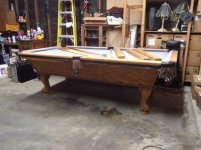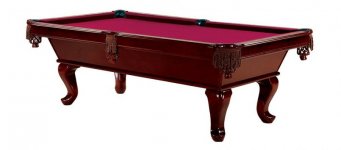92GTA
Registered
I have a Olhausen table with what they say is "American Walnut Finish on Oak ". I am looking to remove the current finish and re-stain the wood after repairs then spray a lacquer clear coat over the stain. The finish is currently a VERY light brown which is almost all worn off anyway.
1) What is recommended to complete removal of the current finish? Just sand paper by hand or a chemical remover? All by hand would be allot of work on the carving on the legs. Pad sander would be good for all the flat surfaces though. What chemicals/sand paper grit is recommended?
2) Next, what brand/type of stain would come out the best on this type of wood? I'm wanting a medium to dark cherry look, something rich. I'm just guessing a couple coats would do it then I can hit it with the lacquer clear to preserve it. Lastly, is there even something other than a lacquer clear you guys would recommend to preserve it the appearance? Note that there are children and pets in the home so I need something tough, I was originally thinking an epoxy like a bar top but then though a lacquer clear would be better.
3) I would like to put something on the bottom surface of the feet, like a thin piece of rubber or plastic that will also work to hold the bottom together against cracking, chipping, etc. What is recommended here?
Thanks!
Alex
1) What is recommended to complete removal of the current finish? Just sand paper by hand or a chemical remover? All by hand would be allot of work on the carving on the legs. Pad sander would be good for all the flat surfaces though. What chemicals/sand paper grit is recommended?
2) Next, what brand/type of stain would come out the best on this type of wood? I'm wanting a medium to dark cherry look, something rich. I'm just guessing a couple coats would do it then I can hit it with the lacquer clear to preserve it. Lastly, is there even something other than a lacquer clear you guys would recommend to preserve it the appearance? Note that there are children and pets in the home so I need something tough, I was originally thinking an epoxy like a bar top but then though a lacquer clear would be better.
3) I would like to put something on the bottom surface of the feet, like a thin piece of rubber or plastic that will also work to hold the bottom together against cracking, chipping, etc. What is recommended here?
Thanks!
Alex
Last edited:

